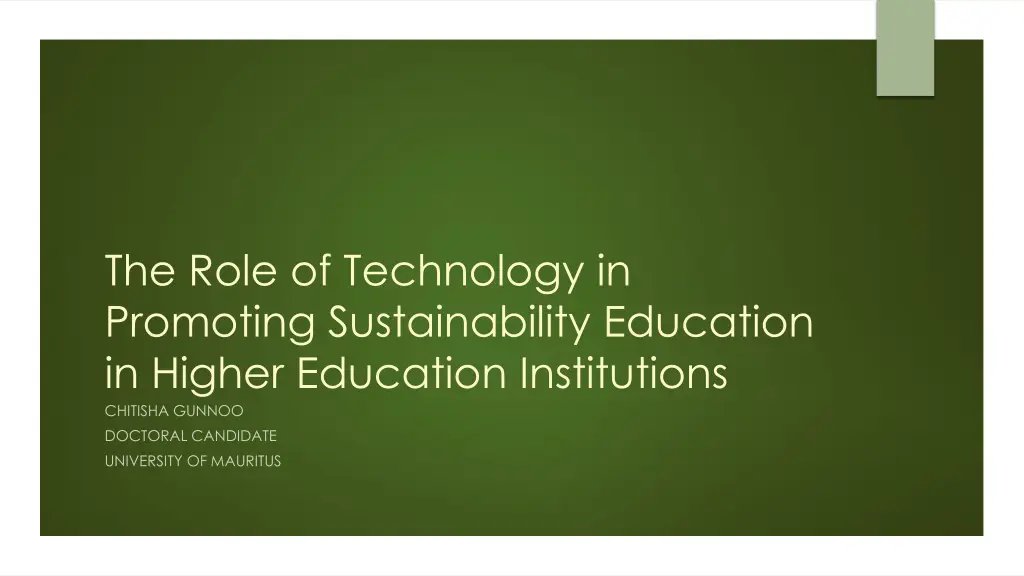
Promoting Sustainability Education Through Technology
Explore the pivotal role of technology in advancing sustainability education within higher education institutions (HEIs). Discover how technology can reshape curricula, facilitate campus sustainability initiatives, and foster global partnerships. Benefit from examples showcasing the multifaceted impacts of technology in promoting sustainability education, and understand its benefits in cultivating collaborative opportunities, critical thinking, creativity, and constructive action among students.
Uploaded on | 1 Views
Download Presentation

Please find below an Image/Link to download the presentation.
The content on the website is provided AS IS for your information and personal use only. It may not be sold, licensed, or shared on other websites without obtaining consent from the author. If you encounter any issues during the download, it is possible that the publisher has removed the file from their server.
You are allowed to download the files provided on this website for personal or commercial use, subject to the condition that they are used lawfully. All files are the property of their respective owners.
The content on the website is provided AS IS for your information and personal use only. It may not be sold, licensed, or shared on other websites without obtaining consent from the author.
E N D
Presentation Transcript
The Role of Technology in Promoting Sustainability Education in Higher Education Institutions CHITISHA GUNNOO DOCTORAL CANDIDATE UNIVERSITY OF MAURITUS
Introduction The integration of technology in higher education institutions (HEIs) has the potential to promote sustainability education and contribute to sustainable development. This study aims to explore the role of technology in promoting sustainability education in HEIs.
Contents The study draws on a review of the literature on the topic, including recent research insights and conceptualizations of the impacts of HEIs on sustainable development. The findings suggest that technology can support sustainability education in HEIs through various approaches and strategies. For example, technology can be used to redesign curricula, promote sustainable campus initiatives, and foster regional and global partnerships.
Role of technology Technology can be used to provide students with an experience that brings opportunities to work collaboratively, appreciate multiple perspectives, think critically and creatively, and act constructively. However, the existing curriculum in higher education has not been developed to examine how we can shape a sustainable world.
Examples The role of technology in promoting sustainability education in higher education institutions (HEIs) is multifaceted and impactful. Examples of how technology can support sustainability education in HEIs: Redesigning curricula: Technology can be utilized to integrate sustainability concepts across various disciplines, ensuring that students are exposed to the principles of sustainable development in their academic pursuits. Promoting sustainable campus initiatives: HEIs can leverage technology to implement and monitor sustainable practices within their campuses, such as energy-efficient systems, waste reduction, and green infrastructure Fostering regional and global partnerships: Technology facilitates collaboration and knowledge-sharing among HEIs globally, enabling the exchange of best practices and innovative approaches to sustainability education.
Benefits Benefits of using technology to provide students with an experience that brings opportunities to work collaboratively, appreciate multiple perspectives, think critically and creatively, and act constructively: Collaborative opportunities Technology enables students to engage in collaborative projects and discussions, fostering teamwork and the exchange of diverse perspectives. Critical thinking and creativity Through technology-enhanced learning experiences, students can develop critical thinking skills by analyzing complex sustainability challenges and proposing creative solutions. Constructive action: Technology can empower students to translate their learning into real-world action, encouraging them to apply sustainable practices in their personal and professional lives.
Challenges Resistance to change: Implementing technology-driven sustainability education may face resistance from traditional academic structures and faculty members who are accustomed to conventional teaching methods. Resource constraints: HEIs may encounter challenges in terms of financial resources, infrastructure, and faculty training required to effectively integrate technology into sustainability education. Pedagogical transformation: Adapting teaching methodologies to effectively utilize technology for sustainability education may require significant pedagogical transformation, posing a challenge for educators and administrators.
Opportunities Holistic approaches: HEIs have the opportunity to adopt integrated and holistic approaches to sustainability education, leveraging technology to offer a sustainable experience to students and guide actions towards sustainability throughout the entire university system. Global awareness and support: There is a global awareness and impetus for a shift in HEIs towards sustainable development, supported by initiatives such as the UNESCO Decade of Education for Sustainable Development, providing a conducive environment for integrating technology in sustainability education. Skills development: Technology-driven sustainability education can focus on developing skills required for sustainable development, enabling students to acquire the knowledge and competencies necessary to make a lasting difference in addressing sustainability challenges.
Conclusion Integrating technology in sustainability education within higher education institutions (HEIs) presents both challenges and opportunities. HEIs have a key responsibility regarding the sustainable development of society, particularly in the education of future leaders and in the public awareness of sustainability. Integrating sustainability education into pedagogical approaches and equipping students with the skills needed to become change agents for sustainable development is crucial. Technology can support sustainability education in HEIs through various approaches and strategies, such as redesigning curricula, promoting sustainable campus initiatives, and fostering regional and global partnerships. Technology can also provide students with an experience that brings opportunities to work collaboratively, appreciate multiple perspectives, think critically and creatively, and act constructively. However, it is important to identify a clear research gap and develop a well-justified plan of action to fill that gap. Further research is needed to explore the effectiveness of different approaches and strategies for integrating technology in sustainability education in HEIs. By doing so, HEIs can maximize the potential of technology in promoting sustainability education and contributing to sustainable development.
